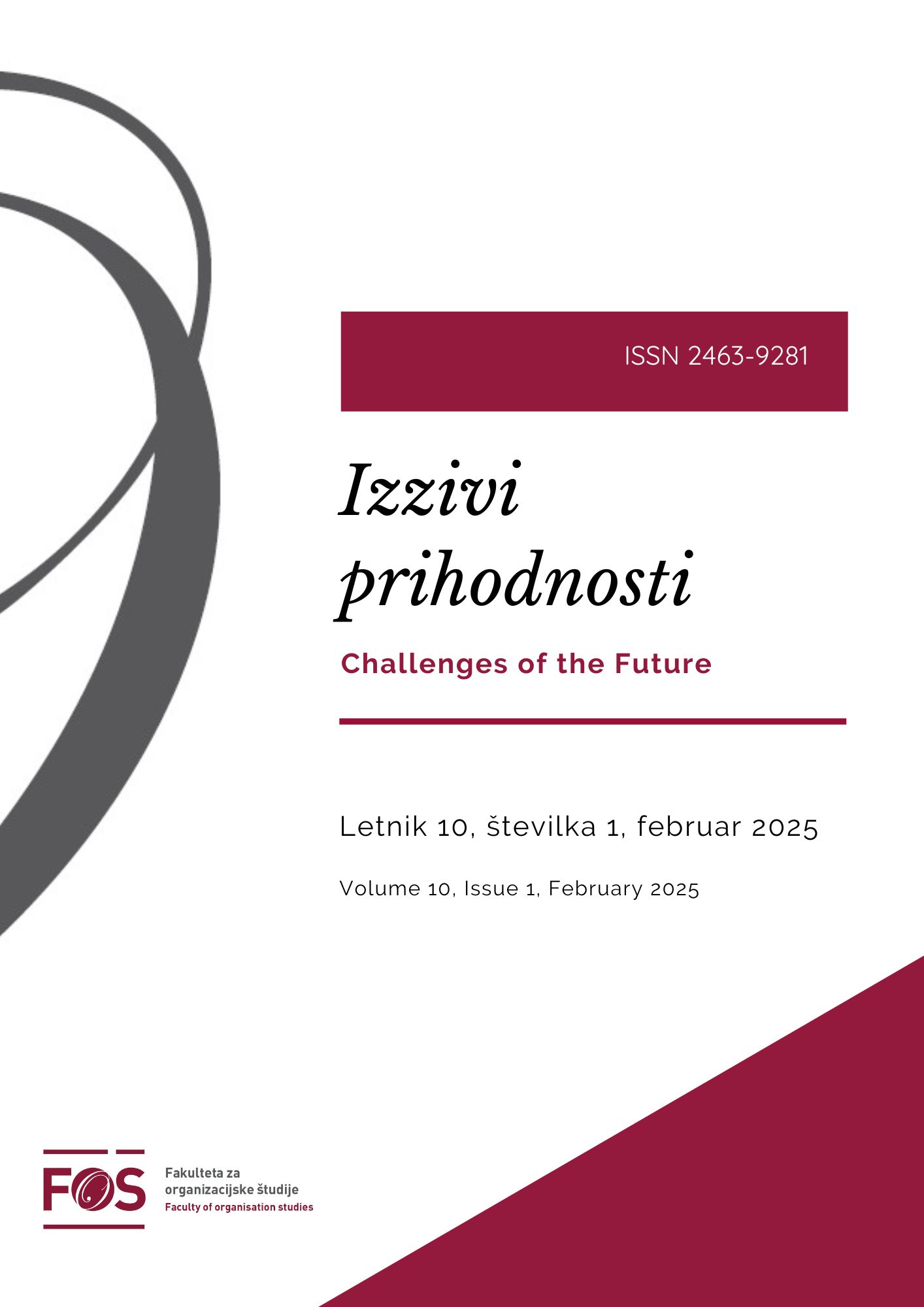Productivity through the Lens of Bibliometric Analysis
DOI:
https://doi.org/10.37886/ip.2025.001Keywords:
economics, productivity, labor, transhumanismAbstract
The present study focuses on the analysis of the development of the concept of 'work productivity', which has emerged as a fundamental term in the field of business economics over the past 90 years. The authors, using bibliometric analysis, specifically co-occurrence and coupling analysis, identified paradigm shifts and intellectual development in this area by examining 13,575 articles from the Web of Science database. They also contemplated potential directions for future research. As the most likely possibility, they highlighted the connection between the concept of work productivity and the idea of transhumanism, which aims to integrate humans and innovations in artificial intelligence.
References
Acemoglu, D., & Restrepo, P. (2022). Demographics and automation. The Review of Economic Studies, 89(1), 1-44
Ali, S. H., Al-Sultan , H. A., & Al Rubaie, M. T. (2022). Fifth Industrial Revolution: (New Perspectives). International Journal of Business, Management and Economics, 3(3), 196 - 212.
Autor, D., Dorn, D., Katz, L. F., Patterson, C., & Van Reenen, J. (2020). The fall of the labor share and the rise of superstar firms. The Quarterly Journal of Economics, 135(2), 645-709.
Bevis, L. E., & Barrett, C. B. (2020). Close to the edge: High productivity at plot peripheries and the inverse size-productivity relationship. Journal of Development Economics, 143, 102377.
Bidadanure, J. (2019). The Political Theory of Universal Basic Income. Annual Review of Political Science, 22, 481-501.
Bloom, N., Draca, M., & Van Reenen, J. (2016). Trade induced technical change? The impact of Chinese imports on innovation, IT and productivity. The review of economic studies, 83(1), 87-117.
Cai, X., Lu, Y., & Wang, J. (2018). The impact of temperature on manufacturing worker productivity: evidence from personnel data. Journal of Comparative Economics, 46(4), 889-905.
Cheng, H., Wang, Z., Peng, D., & Kong, Q. (2020). Firm’s outward foreign direct investment and efficiency loss of factor price distortion: Evidence from Chinese firms. International Review of Economics & Finance, 67, 176-188
Chursinova, O., & Sinelnikova, M. (2024). Post-Human and Trans-Human in the Future Perspective of the Humanity. Filosofija. Sociologija, 35(1).
Ciarli, T., Kenney, M., Massini, S., & Piscitello, L. (2021). Digital technologies, innovation, and skills: Emerging trajectories and challenges. Research Policy, 50(7), 104289.
Coluccia, B., Valente, D., Fusco, G., De Leo, F., & Porrini, D. (2020). Assessing agricultural eco-efficiency in Italian Regions. Ecological Indicators, 116, 106483.
Czyżewski, B., Matuszczak, A., Grzelak, A., Guth, M., & Majchrzak, A. (2021). Environmental sustainable value in agriculture revisited: How does Common Agricultural Policy contribute to eco-efficiency?. Sustainability Science, 16, 137-152.
Dagar, V., Khan, M. K., Alvarado, R., Usman, M., Zakari, A., Rehman, A., ... & Tillaguango, B. (2021). Variations in technical efficiency of farmers with distinct land size across agro-climatic zones: Evidence from India. Journal of Cleaner Production, 315, 128109.
Damioli, G., Van Roy, V., & Vertesy, D. (2021). The impact of artificial intelligence on labor productivity. Eurasian Business Review, 11, 1-25.
Daraio, C., Kerstens, K., Nepomuceno, T., & Sickles, R. C. (2020). Empirical surveys of frontier applications: a meta‐review. International Transactions in Operational Research, 27(2), 709-738.
De Loecker, J., Eeckhout, J., & Unger, G. (2020). The rise of market power and the macroeconomic implications. The Quarterly Journal of Economics, 135(2), 561-644.
Drucker, P. F. (1999). Knowledge-worker productivity: The biggest challenge. California management review, 41(2), 79-94.
El-Gohary, K. M., & Aziz, R. F. (2014). Factors influencing construction labor productivity in Egypt. Journal of management in engineering, 30(1), 1-9.
El Zaatari, S., Marei, M., Li, W., & Usman, Z. (2019). Cobot programming for collaborative industrial tasks: An overview. Robotics and Autonomous Systems, 116, 162-180.
Galanti, T., Guidetti, G., Mazzei, E., Zappalà, S., & Toscano, F. (2021). Work from home during the COVID-19 outbreak: The impact on employees’ remote work productivity, engagement, and stress. Journal of occupational and environmental medicine, 63(7), e426-e432.
Geraci, R. M. (2012). Cyborgs, robots, and eternal avatars: Transhumanist salvation at the interface of brains and machines. In The Routledge companion to religion and science (pp. 578-590). Routledge.
Gołaś, M., Sulewski, P., Wąs, A., Kłoczko-Gajewska, A., & Pogodzińska, K. (2020). On the way to sustainable agriculture—eco-efficiency of polish commercial farms. Agriculture, 10(10), 438.
Greely, H. T. (2016). The end of sex and the future of human reproduction. Harvard University Press.
Grigoli, F., Koczan, Z., & Topalova, P. (2020). Automation and labor force participation in advanced economies: Macro and micro evidence. European Economic Review, 126, 103443.
Harari, Y. N. (2017). Homo deus. Kratka zgodovina prihodnosti. Ljubljana: Mladinska knjiga.
Hau, H., Huang, Y., & Wang, G. (2020). Firm response to competitive shocks: Evidence from China’s minimum wage policy. The Review of Economic Studies, 87(6), 2639-2671.
Helfand, S. M., & Taylor, M. P. (2021). The inverse relationship between farm size and productivity: Refocusing the debate. Food Policy, 99, 101977.
Huang, K. P., Tung, J., Lo, S. C., & Chou, M. J. (2013). A review and critical analysis of the principles of scientific management. International Journal of Organizational Innovation (Online), 5(4), 78.
Huang, Sihan, Baicun Wang, Xingyu Li, Pai Zheng, Dimitris Mourtzis, and Lihui Wang. "Industry 5.0 and Society 5.0—Comparison, complementation and co-evolution." Journal of manufacturing systems 64 (2022): 424-428.
Kass, L. R. (2003). Ageless bodies, happy souls: biotechnology and the pursuit of perfection. The New Atlantis, (1), 9-28.
Kehrig, M., & Vincent, N. (2021). The micro-level anatomy of the labor share decline. The Quarterly Journal of Economics, 136(2), 1031-1087.
Kloutsiniotis, P. V., & Mihail, D. M. (2020). The effects of high performance work systems in employees’ service-oriented OCB. International Journal of Hospitality Management, 90, 102610.
Koch, M., Manuylov, I., & Smolka, M. (2021). Robots and firms. The Economic Journal, 131(638), 2553-2584.
Lamovšek, A., & Černe, M. (2023). Past, present and future: A systematic multitechnique bibliometric review of the field of distributed work. Information and Organization, 100446.
La Torre, G., De Leonardis, V., & Chiappetta, M. (2020). Technostress: how does it affect the productivity and life of an individual? Results of an observational study. Public Health, 189, 60-65.
Lee, Y. L. A., Malik, A., Rosenberger III, P. J., & Sharma, P. (2020). Demystifying the differences in the impact of training and incentives on employee performance: mediating roles of trust and knowledge sharing. Journal of Knowledge Management, 24(8), 1987-2006.
Letvak, S., & Buck, R. (2008). Factors influencing work productivity and intent to stay in nursing. Nursing economic$, 26(3).
Li, J., Shan, Y., Tian, G., & Hao, X. (2020). Labor cost, government intervention, and corporate innovation: Evidence from China. Journal of Corporate Finance, 64, 101668.
Li, L., & Wang, X. (2021). Technostress inhibitors and creators and their impacts on university teachers’ work performance in higher education. Cognition, Technology & Work, 23, 315-330.
Liao, Y., Loures, E. R., Deschamps, F., Brezinski, G., & Venâncio, A. (2017). The impact of the fourth industrial revolution: a cross-country/region comparison. Production, 28.
Martín-de Castro, G., Díez-Vial, I., & Delgado-Verde, M. (2019). Intellectual capital and the firm: evolution and research trends. Journal of Intellectual Capital.
Maruta, A. A., Banerjee, R., & Cavoli, T. (2020). Foreign aid, institutional quality and economic growth: Evidence from the developing world. Economic Modelling, 89, 444-463.
Matthes, J., Karsay, K., Schmuck, D., & Stevic, A. (2020). “Too much to handle”: Impact of mobile social networking sites on information overload, depressive symptoms, and well-being, Computers in Human Behavior, 105, article 106217.
Mayo, E. (1923). The irrational factor in human behavior: the" night-mind" in industry. The Annals of the American Academy of Political and Social Science, 110(1), 117-130.
Naoum, S. G. (2016). Factors influencing labor productivity on construction sites: A state-of-the-art literature review and a survey. International journal of productivity and performance management, 65(3), 401-421.
Neuralink. Neuralink's first human patient able to control mouse through thinking. Najedeno 10. marca 2024 na: https://www.reuters.com/business/healthcare-pharmaceuticals/neuralinks-first-human-patient-able-control-mouse-through-thinking-musk-says-2024-02-20/
Obrenovic, B., Jianguo, D., Khudaykulov, A., & Khan, M. A. S. (2020). Work-family conflict impact on psychological safety and psychological well-being: A job performance model. Frontiers in psychology, 11, 475.
Palvalin, M. (2019). What matters for knowledge work productivity?. Employee Relations, 41(1), 209-227.
Porter, A. (2017). Bioethics and transhumanism. Journal of Medicine and Philosophy, 42(3), 237-260.
Rai, S., & Rai, A. (2015). Nanotechnology - The secret of fifth industrial revolution and the future of next generation. Nusantara Bioscience 7(3), 61-66.
Ramos‐Rodríguez, A. R., & Ruíz‐Navarro, J. (2004). Changes in the intellectual structure of strategic management research: A bibliometric study of the Strategic Management Journal, 1980–2000. Strategic management journal, 25(10), 981-1004.
Ronda-Pupo, G., & Guerras-Martín, L. (2010). Dynamics of the scientific community network within the strategic management field through the Strategic Management Journal 1980–2009: the role of cooperation. Scientometrics, 85(3), 821-848.
Rosekind, M. R., Gregory, K. B., Mallis, M. M., Brandt, S. L., Seal, B., & Lerner, D. (2010). The cost of poor sleep: workplace productivity loss and associated costs. Journal of Occupational and Environmental Medicine, 52(1), 91-98.
Rothman, B. S., Gupta, R. K., & McEvoy, M. D. (2017). Mobile Technology in the Perioperative Arena: Rapid Evolution and Future Disruption. Anesthesia & Analgesia 124(3), 807-818.
Schwab, K. (2017). The fourth industrial revolution. Crown Currency.
Shekhar, S. S. (2019). Artificial intelligence in automation. Artificial Intelligence, 3085(06), 14-17.
Shirish, A., Chandra, S., & Srivastava, S. C. (2021). Switching to online learning during COVID-19: Theorizing the role of IT mindfulness and techno eustress for facilitating productivity and creativity in student learning. International Journal of Information Management, 61, 102394.
Spektor, F., & Fox, S. (2020). The ‘working body’: interrogating and reimagining the productivist impulses of transhumanism through crip-centered speculative design. Somatechnics, 10(3), 327-354.
Taneja, S., Pryor, M. G., & Toombs, L. A. (2011). Frederick W. Taylor's scientific management principles: Relevance and validity. Journal of Applied Management and Entrepreneurship, 16(3), 60.
Taylor, F. W. (2004). Scientific management. Routledge.
Tirosh‐Samuelson, H. (2012). Transhumanism as a secularist faith. Zygon®, 47(4), 710-734.
Thompson, J. (2017). Transhumanism: How Far Is Too Far?, The New Bioethics, 23(2), 165-182.
Troth, A. C., & Guest, D. E. (2020). The case for psychology in human resource management research. Human Resource Management Journal, 30(1), 34-48.
Upadhyaya, P., & Vrinda. (2021). Impact of technostress on academic productivity of university students. Education and Information Technologies, 26, 1647-1664.
Watson, D. (2019). Fordism: A review essay. Labor History, 60(2), 144-159.
Zhang, Q., & Ma, Y. (2021). The impact of environmental management on firm economic performance: The mediating effect of green innovation and the moderating effect of environmental leadership. Journal of Cleaner Production, 292, 126057.
Zhao, D., & Strotmann, A. (2008). Evolution of research activities and intellectual influences in information science 1996–2005: Introducing author bibliographic‐coupling analysis. Journal of the American Society for Information Science and Technology, 59(13), 2070-2086.
Zhao, X., Xia, Q., & Huang, W. (2020). Impact of technostress on productivity from the theoretical perspective of appraisal and coping processes. Information & Management, 57(8), 103265.
Zupic, I., & Čater, T. (2015). Bibliometric methods in management and organization. Organizational research methods, 18(3), 429-472.
Additional Files
Published
How to Cite
Issue
Section
License
Copyright (c) 2025 Fabijan Leskovec, Igor Ivašković

This work is licensed under a Creative Commons Attribution-ShareAlike 4.0 International License.
![]()








